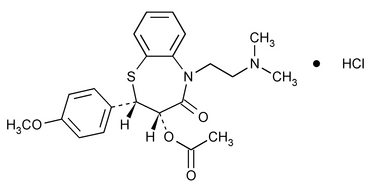Diltiazem Hydrochloride
(dil tye' a zem hye'' droe klor' ide).
1,5-Benzothiazepin-4(5H)-one, 3-(acetyloxy)-5-[2-(dimethylamino)ethyl]-2,3-dihydro-2-(4-methoxyphenyl)-, monohydrochloride, (+)-cis-.
(+)-5-[2-(Dimethylamino)ethyl]-cis-2,3-dihydro-3-hydroxy-2-(p-methoxyphenyl)-1,5-benzothiazepin-4(5H)-one acetate (ester) monohydrochloride
» Diltiazem Hydrochloride contains not less than 98.0 percent and not more than 102.0 percent of C22H26N2O4S·HCl, calculated on the dried basis.
Packaging and storage—
Preserve in tight, light-resistant containers.
USP Reference standards  11
11 —
—
USP Desacetyl Diltiazem Hydrochloride RS
C20H24N2O3S·HCl 408.95
C20H24N2O3S·HCl 408.95
Identification—
B:
The retention time of the major peak in the chromatogram of the Assay preparation corresponds to that in the chromatogram of the Standard preparation, obtained as directed in the Assay.
C:
It responds to the tests for Chloride  191
191 .
.
Loss on drying  731
731 —
Dry it at 105
—
Dry it at 105 for 2 hours: it loses not more than 0.5% of its weight.
for 2 hours: it loses not more than 0.5% of its weight.
Residue on ignition  281
281 :
not more than 0.1%.
:
not more than 0.1%.
Heavy metals  231
231 :
not more than 20 ppm.
:
not more than 20 ppm.
Related compounds—
Buffer
and Mobile phase—Prepare as directed in the Assay.
Standard solution—
Use the System suitability preparation prepared as directed under Assay.
Test solution—
Prepare as directed for the Assay preparation in the Assay.
Chromatographic system—
Prepare as directed under Assay. The relative standard deviation of the peak response for replicate injections of the Standard solution is not more than 10.0%.
Procedure—
Separately inject equal volumes (about 10 µL) of the Standard solution and the Test solution into the chromatograph, record the chromatograms, and measure the responses for all of the peaks. The relative retention times are about 0.65 for desacetyl diltiazem and 1.0 for diltiazem. Calculate the percentage of desacetyl diltiazem hydrochloride in the specimen of Diltiazem Hydrochloride taken by the formula:
10(C / W)(rU / rS)
in which C is the concentration, in µg per mL, of USP Desacetyl Diltiazem Hydrochloride RS in the Standard solution, W is the weight, in mg, of Diltiazem Hydrochloride taken, and rU and rS are the desacetyl diltiazem peak responses obtained from the Test solution and the Standard solution, respectively: not more than 0.5% of desacetyl diltiazem hydrochloride is found. Calculate the percentage of each impurity peak, other than the main peak and the desacetyl diltiazem peak, by the formula:
10(C / W)(rI / rS)
in which rI is the response of each impurity peak and all other quantities are as defined above: not more than 1.0% total impurities including desacetyl diltiazem hydrochloride with no individual impurity greater than 0.5% is found.
Assay—
Buffer—
Dissolve 1.16 g of d-10-camphorsulfonic acid in 1000 mL of 0.1 M sodium acetate, adjust this solution by the addition of 0.1 N sodium hydroxide to a pH of 6.2, and mix.
Mobile phase—
Prepare a mixture of Buffer, acetonitrile, and methanol (50:25:25), filter, and degas. Make adjustments if necessary (see System Suitability under Chromatography  621
621 ).
).
Standard preparation—
Prepare a solution in methanol having an accurately known concentration of about 1.2 mg of USP Diltiazem Hydrochloride RS per mL.
Assay preparation—
Transfer about 120 mg of Diltiazem Hydrochloride, accurately weighed, to a 100-mL volumetric flask, dissolve in methanol, dilute with methanol to volume, and mix.
System suitability preparation—
Prepare a solution in methanol containing 0.012 mg each of USP Diltiazem Hydrochloride RS and USP Desacetyl Diltiazem Hydrochloride RS per mL.
Chromatographic system—
The liquid chromatograph is equipped with a 240-nm detector and a 3.9-mm × 30-cm column that contains packing L1. The flow rate is about 1.6 mL per minute. Chromatograph the System suitability preparation, and record the peak responses as directed for Procedure: the relative retention times are about 0.65 for desacetyl diltiazem and 1.0 for diltiazem, the resolution, R, between desacetyl diltiazem and diltiazem is not less than 3, and the number of theoretical plates, n, for the diltiazem peak is not less than 1200. Chromatograph the Standard preparation, and record the peak responses as directed for Procedure: the relative standard deviation for replicate injections is not more than 2.0%.
Procedure—
Separately inject equal volumes (about 10 µL) of the Standard preparation and the Assay preparation into the chromatograph, record the chromatograms, and measure the responses for the major peaks. Calculate the quantity, in mg, of C22H26N2O4S·HCl in the Diltiazem Hydrochloride taken by the formula:
100C(rU / rS)
in which C is the concentration, in mg per mL, of USP Diltiazem Hydrochloride RS in the Standard preparation, and rU and rS are the peak responses obtained from the Assay preparation and the Standard preparation, respectively.
Auxiliary Information—
Please check for your question in the FAQs before contacting USP.
| Topic/Question | Contact | Expert Committee |
|---|---|---|
| Monograph | Sujatha Ramakrishna, Ph.D.
Senior Scientific Liaison 1-301-816-8349 |
(SM22010) Monographs - Small Molecules 2 |
| Reference Standards | RS Technical Services 1-301-816-8129 rstech@usp.org |
USP35–NF30 Page 2916
Pharmacopeial Forum: Volume No. 33(5) Page 907

